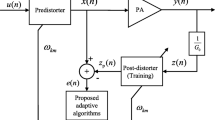Abstract
Computational intelligent systems are becoming an increasingly attractive solution for power amplifier (PA) behavioural modelling, due to their excellent approximation capability. This paper utilizes an adaptive fuzzy logic system (AFLS) for the modelling of the highly nonlinear MIMIX CFH2162-P3 PA. Moreover, PA’s inverse model based also on AFLS has been developed in order to act as a pre-distorter unit. Driving an LTE 1.4 MHz 64 QAM signal at 880 MHz as centre frequency at PA’s input, very good modelling performance was achieved, for both PA’s forward and inverse dynamics. A comparative study of AFLS and neural networks (NN) has been carried out to establish AFLS as an effective, robust and easy-to-implement baseband model, which is suitable for inverse modelling of PAs and capable to be used as an effective digital pre-distorter. Pre-distortion system based on AFLS achieved distortion suppression of 84.2%, compared to the 48.4% gained using the NN-based equivalent scheme.
















Similar content being viewed by others
References
Kenington PB (2000) High-linearity RF amplifier design. Artech House, Boston
Raab FH, Asbeck P, Cripps S, Kenington PB, Popovic ZB, Pothecary N, Sevic JF, Sokal NO (2002) Power amplifiers and transmitters for RF and microwave. IEEE Trans Microw Theory Tech 50(3):814–826
Braithwaite RN, Khanifar A (2013) High efficiency feedforward power amplifier using a nonlinear error amplifier and offset alignment control. In: IEEE MTT-S international microwave symposium, Seattle, WA, pp 1–4
Kim Y, Yang Y, Kang SH, Kim B (1998) Linearization of 1.85 GHz amplifier using feedback predistortion loop. In: IEEE MTT-S International Microwave Symposium Digest, Baltimore, MD, pp 1675–1678
Yi J, Yang Y, Park M, Kang W, Kim B (2000) Analog predistortion linearizer for high-power RF amplifiers. IEEE Trans Microw Theory Tech 48(12):2709–2713
Jeckeln EG, Ghannouchi FM, Sawan MA (2004) A new adaptive predistortion technique using software-defined radio and DSP technologies suitable for base station 3G power amplifiers. IEEE Trans Microw Theory Tech 52(9):2139–2147
Zhu A, Wren M, Brazil TJ (2003) An efficient volterra-based behavioral model for wideband RF power amplifiers. IEEE MTT-S Int Microw Symp Dig 2:787–790
Jardin P, Baudoin G (2007) Filter lookup table method for power amplifier linearization. IEEE Trans Veh Technol 56:1076–1087
Ku HC, McKinley MD, Kenney JS (2002) Quantifying memory effects in RF power amplifiers. IEEE Trans Microw Theory Tech 50(12):2843–2849
Morgan R, Zhengxiang M, Kim L, Zierdt MG, Pastalan I (2006) A generalized memory polynomial model for digital predistortion of RF power amplifiers. IEEE Trans Signal Process 54(10):3852–3860
Boumaiza S, Mkadem F (2009) Wideband RF power amplifier predistortion using real-valued time-delay neural networks. In: European microwave conference, EuMC2009, pp 1449–1452
Gil Jiménez VP, Jabrane Y, García Armada A, Ait Es Said B, Ait Ouahman A (2011) High power amplifier pre-distorter based on neural-fuzzy systems for OFDM signals. IEEE Trans Broadcast 57(1):149–158
Naskas N, Papananos Y (2002) Adaptive baseband predistorter for radio frequency power amplifiers based on a multilayer perceptron. In: 9th International electronics circuits, systems conference, vol 3(11). pp 1107–1110
Lee KC, Gardner P (2006) Adaptive neuro-fuzzy inference system (ANFIS) digital predistorter for RF power amplifier linearization. IEEE Trans Veh Technol 55(1):43–51
Zhai J, Zhou J, Zhang L, Zhao J, Hong W (2009) The dynamic behavioral model of RF power amplifiers with the modified ANFIS. IEEE Trans Microw Theory Tech 57(1):27–35
Jang JSR, Sun CT, Mizutani E (1997) Neuro-fuzzy and soft computing: a computational approach to learning and machine intelligence. Prentice-Hall, Upper Saddle River
Rawat M, Rawat K, Ghannouchi FM (2010) Adaptive digital predistortion of wireless power amplifiers/transmitters using dynamic real-valued focused time-delay line neural networks. IEEE Trans Microw Theory Tech 58(1):95–104
Liu T, Boumaiza S, Ghannouchi F (2004) Dynamic behavioural modeling of 3G power amplifiers using real-valued time-delay neural networks. IEEE Trans Microw Theory Tech 52(3):1025–1033
Tsoukalas LH, Uhrig RE (1997) Fuzzy and neural approaches in engineering. Wiley, New York
Nelles O (2000) Nonlinear system identification: from classical approaches to neural networks and fuzzy models. Springer, Berlin
Mendel J (2001) Uncertain rule-based fuzzy logic systems. Prentice Hall, Upper Saddle River
Wang LX (1994) Adaptive fuzzy systems and control. Prentice Hall Inc, Englewood Cliffs
Kodogiannis VS, Petrounias I, Lygouras JN (2008) Intelligent classification using adaptive fuzzy logic systems. In: IS2008—IEEE international conference on intelligent systems, Bulgaria, pp 8–13
Kosko B (1992) Neural networks and fuzzy systems: a dynamical systems approach to machine intelligence. Prentice-Hall, Upper Saddle River
Vaskovic M (2014) Compensation of nonlinear distortion in RF amplifiers for mobile communications, Ph.D. thesis, University of Westminster, United Kingdom
Melvin SH, Baro M, Jandali M, Ilow J (2008) Improved compensation of HPA nonlinearities using digital predistorters with dynamic and multi-dimensional LUTs. In: Proceedings of the 6th annual communication networks and services research conference, CNSR 2008, pp 46–52
Roy TK, Morshed M (2013) High power amplifier effects analysis for OFDM system. Int J Sci Eng Technol Res 2(5):1119–1121
Zhi-yong H, Jian-hua G, Shu-jian G, Gang W (2006) An improved look-up table predistortion technique for HPA with memory effects in OFDM systems. IEEE Trans Broadcast 52(1):87–91
Li M, Liu J, Jiang Y, Feng W (2012) Complex-chebyshev functional link neural network behavioural model for broadband wireless power amplifiers. IEEE Trans Microw Theory Tech 60(6):1979–1989
Fu K, Law CL, Thein TT (2013) Novel neural network model of power amplifier plus IQ imbalances. Prog Electromagn Res B 46:177–192
Kodogiannis VS, Anagnostakis EM (2002) Soft Computing based techniques for short-term load forecasting. Fuzzy Sets Syst 128(3):413–426
Lin C-T, George Lee CS (1996) Neural fuzzy systems: a neuro-fuzzy synergism to intelligent systems. Prentice Hall, Upper Saddle River
Author information
Authors and Affiliations
Corresponding author
Rights and permissions
About this article
Cite this article
Vaskovic, M., Kodogiannis, V.S. & Budimir, D. An adaptive fuzzy logic system for the compensation of nonlinear distortion in wireless power amplifiers. Neural Comput & Applic 30, 2539–2554 (2018). https://doi.org/10.1007/s00521-017-2849-3
Received:
Accepted:
Published:
Issue Date:
DOI: https://doi.org/10.1007/s00521-017-2849-3




